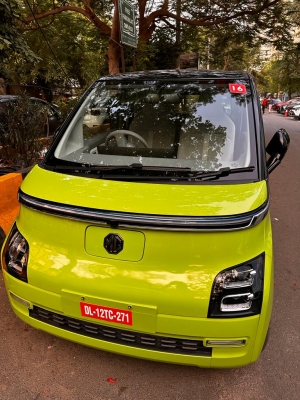By Nishant AroraNew Delhi, May 14 : As India, which is the fourth largest car market globally, charts a new course for electric vehicles (EVs), the country still has EV penetration at only around 1 per cent (according to Moody’s) – and that too dominated by electric two-wheelers.
However, with the friendly government policies and new entrants arriving on the scene with cheaper EVs, the country is set to witness a plethora of options in the next 2-3 years.
Industry experts expect that passenger car EV penetration will cross 21 per cent by 2027 from 1.3 per cent in 2022.
Tata Motors is currently leading the Indian passenger electric vehicle (EV) market, followed by MG Motor, and Hyundai Motor.
“MG Motor’s recent launch of the Comet EV priced under Rs 10 lakh is expected to be a game-changer for urban EV adoption,” senior analyst Soumen Mandal from Counterpoint Research told IANS.
Comet EV offers a certified battery range of around 230 km on a single charge.According to the company, the new Comet EV has been evaluated to provide an encouraging and economical charging cost of Rs 519 per month.
Maruti Suzuki is also working on developing its own battery technology before launching pure EV models.
Tata Motors has already established an operational battery plant, which has helped the company to reduce its EV price point.
As per CyberMedia Research (CMR), the Indian electric vehicle (EV) market is growing rapidly, with a year-on-year growth rate of approximately 48 per cent in the first quarter of 2023.
The electric 2-wheeler (E2W) market grew by 44 per cent YoY.The electric 3-wheeler (E3W) market grew steadily covering around 50 per cent share within the segment.
“There is growing consumer awareness around connected vehicle technologies.For instance, connected vehicle tech has consistently increased its footprint in the industry,” said John Martin, senior analyst, smart mobility practice, CMR.
The electric passenger vehicle (EPV) segment grew over 114 per cent YoY in Q1 in India.
By Q1 2025, the EV market share in India is expected to surpass 24 per cent.
In its report, Moody’s Investors Service said last month that various government incentives will drive an increase in EV penetration.
“These include consumer incentives, production-linked incentives for advanced battery storage to drive local cell manufacturing, goods and services tax (GST) rate cuts, and other state-level subsidies,” the report said.
With the demand for affordable transportation and the focus on reducing carbon emissions, electric vehicles will play a vital role in India’s step towards a sustainable future.
Consumers are increasingly picking EVs, understanding that the total cost of ownership (TCO) is more favourable than their petrol counterparts, over 50 per cent for high usage such as delivery, according to a latest RedSeer report.
As of 2022, India’s overall EV penetration, including 2W, is 3 per cent and although the electrification of mobility in India is still at a nascent stage, “there is massive headroom for growth”, the report noted.
(Nishant Arora can be reached at [email protected])
na/vd
#diesel #cars #slow #gear #Delhi #Delhi #New Delhi #Bally #Tata Motors #Tata







